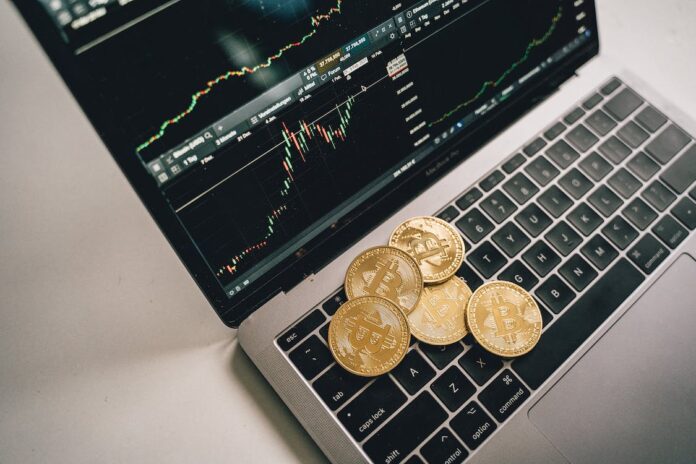Cryptocurrency trading is a captivating and vibrant world. As the digital revolution rules, understanding how to trade crypto is essential and exciting for those seeking money. It has potential for high returns and volatility like wild waves. Trading crypto offers an opportunity for those daring enough to take on its challenges.
To become successful, it’s important to comprehend the underlying tech and market dynamics. Knowing blockchain, the decentralized ledger tech powering crypto, is the basis for any trader, including those on “Immediate Connect Trading App: Fast and efficient.” Moreover, staying up-to-date with the trends and news in this space helps traders on the platform make informed decisions.
It’s crucial to set reasonable goals and have a disciplined approach. Creating a trading strategy tailored to one’s risk tolerance and investment objectives keeps them on track during price fluctuations. Additionally, diversifying one’s crypto portfolio can help reduce risks. Furthermore, doing research and using technical analysis tools aids in identifying entry and exit points.
Be careful when selecting crypto exchanges or trading platforms. Look at security measures, liquidity, fees, user experience, and regulatory compliance to protect investments from risks like scams or hacks. Use reputable exchanges to navigate this ever-changing landscape.
Setting Up a Crypto Trading Account
Trading crypto? Setting up a trading account is essential! It may seem daunting at first, but with the right guidance, it can be easy. Here’s a 6-step guide to help you out:
| Step | Instructions |
| 1 | Research reliable crypto exchanges. Find ones with good security, a user-friendly interface, and plenty of cryptos. |
| 2 | Sign up to your chosen exchange. Visit their site, click the sign-up button, and fill in the required info. Make sure your password is strong. |
| 3 | Verify your identity. Crypto exchanges often need you to provide ID documents, like a passport or driver’s license. Follow the instructions. |
| 4 | Enable two-factor authentication (2FA). Extra layer of protection – you’ll need to provide a unique code. Get it from an authenticator app or SMS. |
| 5 | Deposit funds. Check which deposit options are available and choose the one that works for you. |
| 6 | Purchase or trade cryptos. Time to get trading! |
A few extra tips: stay up-to-date with market trends, manage risks wisely, keep learning and adapting, and secure your account. Plus, remember that the crypto market is open 24/7. Invest what you can afford to lose.
Fun fact: as of August 2021, CoinMarketCap lists over 10,000 different cryptocurrencies available for trading. Now you know how to set up a crypto trading account! Ready to start?
Understanding Different Cryptocurrencies
To understand different cryptocurrencies, delve into Bitcoin, Ethereum, and Ripple. Explore their unique features and potential uses in this digital realm. Gain insights into the world of trading crypto, empowering yourself with knowledge of these prominent cryptocurrencies and their distinct characteristics.
Bitcoin
The following table displays great data on Bitcoin:
|Metric |Value | |—————–|———————–| |Market Cap |£838.60 billion | |Max Supply |21 million BTC | |Block Time |10 minutes | |Transaction Speed|7 transactions per second|
Bitcoin has an interesting limited supply, making it an attractive investment. It was created by an unknown person or group of people, going by the name Satoshi Nakamoto. The identity of Nakamoto is still a mystery.
At first, Bitcoin was mainly used for illegal activities due to its anonymity. Over time, it has become accepted in mainstream businesses and by investors. Now, companies and merchants accept Bitcoin as a payment.
The value of Bitcoin has seen many highs and lows since it started. In 2017 the price went up to nearly £15,000 per coin, then decreased rapidly. Despite how unpredictable it can be, Bitcoin continues to interest investors who see its potential as a store of value and digital currency.
If one wants to understand cryptocurrencies, it’s important to know more about Bitcoin. Its effects on financial systems and technological developments cannot be ignored. The future is uncertain, yet holds possibilities for Bitcoin and those involved in this ever-changing ecosystem.
Ethereum
🖥️💰⛓️
Key Features of Ethereum:
- Smart Contracts: No intermediaries needed! Secure & transparent transactions.
- Decentralized Apps (dApps): Platform to access innovative services worldwide.
- Ether (ETH): Digital currency & fuel to run contracts.
Ethereum’s become popular for ICOs & DeFi – lending, borrowing & yield farming. Pro Tip: Protect your keys – use hardware wallets or cold storage.
Ripple
Ripple is unique. It has the Ripple Protocol Consensus Algorithm (RPCA) which means faster transaction confirmations than Bitcoin or Ethereum. Its network can handle 1,500 transactions a second!
Founder Chris Larsen set up Ripple in 2012 and its current price is £0.50. Its market cap is £21 billion and it has a total supply of 100 billion XRP.
Santander Bank partnered with Ripple to enable international money transfers. Transaction times dropped from days to minutes. This improved their customers’ banking experience.
Ripple continues to be popular with investors and financial institutions. It offers innovative solutions and bridges the gap between traditional banking and blockchain technology.
Analyzing Crypto Market Trends
To effectively analyze crypto market trends in trading crypto, utilise the techniques of Technical Analysis and Fundamental Analysis. These sub-sections offer complementary approaches to understanding market patterns and making informed investment decisions. Technical Analysis focuses on chart patterns and indicators, while Fundamental Analysis evaluates the intrinsic value of cryptocurrencies based on real-world factors. Mastering both methodologies can enhance your trading strategy and increase potential profitability.
Technical Analysis
To illustrate Technical Analysis, here’s a table:
| Currency | Moving Average (50 days) | RSI (14 days) | MACD (12,26) |
| Bitcoin | £32,562 | 58.72 | 1345.69 |
| Ethereum | £2,367 | 64.91 | -276.51 |
| Ripple | £0.517 | 54.36 | 31.78 |
This table shows the moving average (50 days), relative strength index (RSI) over 14 days, and the moving average convergence divergence (MACD) for Bitcoin, Ethereum, and Ripple.
Investors also look at other things, such as candlestick patterns, volume trends, support and resistance levels to make decisions.
Technical Analysis dates back to long ago. Charles Dow developed the Dow Theory which started modern TA practices. Since then, technology has allowed for better tools and techniques for analyzing crypto market trends.
By using Technical Analysis, traders search for patterns and signals in market data. This can help them make better decisions and succeed in the cryptocurrency market.
Fundamental Analysis
Fundamental Analysis is a process that examines various elements. These are:
| • Financial Statements – Balance sheet, income statement and cash flow statement to assess a cryptocurrency’s financial health. |
| • Market Trends – Demand, competition and adoption rates to understand potential growth. |
| • Management Teams – The team’s skills, expertise and track record. |
| • Regulatory Framework – Identifying risks and barriers in the legal and regulatory environment. |
Other unique details can be looked at too, such as tech advancements, partnerships with institutions, and community engagement. These provide insight into a cryptocurrency’s long-term viability.
A great example of Fundamental Analysis in action is Bitcoin’s surge in 2017. Investors analyzed its tech, widespread adoption, increasing public interest and limited supply. This led to a huge demand for Bitcoin, resulting in a huge increase in value.
Strategies for Trading Crypto
To effectively navigate the world of trading cryptocurrencies, equip yourself with key strategies. Implementing the right techniques in day trading, swing trading, and long-term investing is crucial. Let’s delve into these sub-sections and explore the strategies that can optimise your crypto trading journey.
Day Trading
Day trading, which is buying and selling crypto in the same day, can be profitable thanks to short-term price movements. Here are five points to remember:
- Timing is everything: Monitor trends and make trades at the right time for the best profit.
- Risk management is key: Establish stop-loss orders to protect against losses.
- Technical analysis is useful: Charts, patterns, and indicators help you know when to enter and exit trades.
- Leverage can be risky: Use leverage to increase trading position, but be aware of the risks.
- Educate yourself: Learn about crypto, market dynamics, and trading strategies for success.
Day trading requires focus and swift decisions. Also, keep up with news that may affect prices.
If you’re keen to try day trading, begin with trial accounts or small investments. You will need discipline, knowledge, and the ability to control emotions in this volatile market.
Don’t miss out – join the world of fast-paced trading today!
Swing Trading
Swing trading is all about profiting from short-term price changes in the cryptocurrency market. The goal? Grabbing smaller gains over a few days or weeks.
- In swing trading, timing is everything. Traders must analyze patterns and indicators to pinpoint entry and exit points.
- Risk management is a must. Stop-loss orders limit possible losses, while trailing stops safeguard profits by changing when the price moves.
- To identify trends, support and resistance levels, traders rely on chart analysis.
- Patience is required. Swing traders wait for ideal chances before trading, avoiding rash decisions based on emotions or short-term market movements.
Swing traders may also set profit targets to bank in profits and avoid holding positions for too long. By following their strategies and maintaining discipline, swing traders can up their chances of success in the unpredictable crypto market.
Remember, swing trading needs practice and experience. You should always evaluate and improve your tactics based on market conditions. Stay up to date with news and events that can affect cryptocurrencies to make educated trades.
Long-Term Investing
Fundamental analysis is key in this investment strategy – not short-term price changes. Examining a project’s technology, team, roadmap and partnerships gives insight into its potential. Investing in projects that tackle real-world issues and offer value, sets investors up for long-term success.
Additionally, portfolio diversification should be taken into consideration. Investing in different crypto with varying risks, can balance out potential losses from one asset, with gains from another. This diversifying reduces risk from a single project, and maximizes growth possibilities.
A great example of the benefits of long-term investing, is the investor who bought Bitcoin when it was worth very little. Despite facing criticism from friends and family, they held onto their investment for years, through market ups and downs. Eventually, they made substantial profits due to Bitcoin’s soaring value over time. This story shows how belief and patience in a crypto’s long-term potential, can lead to financial gains.
Long-Term Investing is an opportunity to partake in the crypto market’s growth, whilst avoiding short-term volatility. With correct research, picking promising projects, diversifying and faith in a crypto’s future, investors can set themselves up for long-term success.
Risk Management in Crypto Trading
To manage risk in crypto trading with the focus on risk management, let’s discuss three key sub-sections: setting stop-loss orders, diversifying your portfolio, and managing emotions and psychology. Each plays a crucial role in mitigating potential losses and maximizing gains. By implementing these strategies, you can navigate the volatile world of crypto trading with greater confidence and resilience.
Setting Stop-Loss Orders
If you want to set stop-loss orders like a pro, here’s a 4-step guide.
1. Work out your risk tolerance. Think about how much loss you can handle before exiting a trade. This will help determine the right stop-loss level.
2. Find key support levels. Analyze charts and technical indicators to pick out important price levels which could mean the market reverses against you. Put the stop-loss order just below these levels.
3. Use trailing stop. This type of stop-loss adjusts as the price shifts in your favor. It allows for potential profit-making and keeps you safe from sudden drops.
4. Monitor and update. Keep an eye on the market and change your stop-loss orders as needed. Prices can change – so stay alert to ensure you’re always guarded.
Never second-guess or remove a stop-loss order – staying disciplined is vital when managing risk in crypto trading.
Pro Tip: To reduce risks, diversify your portfolio across different cryptocurrencies.
Diversifying Your Portfolio
Diversifying is an essential part of managing your crypto trading portfolio. By diversifying, you spread out your investments across different cryptocurrencies, reducing the risk associated with any single asset. Here are four points to remember when diversifying:
| Choose a variety of cryptos | Consider market capitalization | Analyze project fundamentals | Balance risk and reward |
| Investing in different coins allows you to take advantage of different market trends and avoid too much risk from one coin. | Put your money into coins with different market capitalizations. Big coins like Bitcoin and Ethereum can be stable, while smaller coins can offer good growth potential. | Before investing, look at the development progress and other aspects of different projects. Think about team experience, partnerships, and technology improvements to help limit risk. | Find a balance between high-risk, high-reward investments and more secure options. A diversified portfolio should contain established cryptos and new ones. |
Diversifying your crypto portfolio can reduce the effect of changes in individual assets and maybe improve returns. However, diversification cannot guarantee success or protect completely against losses.
People have known the value of spreading risk for centuries. From sailors with cargoes on multiple ships to merchants with various investments, they have always understood not to put all their eggs in one basket. In today’s fast-paced crypto trading, diversification is still just as important.
Managing Emotions and Psychology
It’s essential to have a professional attitude and avoid impulsive decisions when managing emotions and psychology when trading crypto. Fear and greed can cause bad results.
Creating a plan with entry and exit points can reduce emotional responses. Diversifying investments and setting stop-loss orders can also help manage risk.
Staying aware of market news and trends is important to make informed decisions. Staying calm during market volatility is key to focus and not act impulsively.
John, an experienced trader, is an example of what can go wrong. Fear caused him to sell all his holdings and miss out on huge gains when the market rebounded.
This story shows how managing emotions can bring success in this volatile market.
Choosing a Crypto Exchange
To choose a crypto exchange effectively, consider the factors that matter to you and familiarize yourself with popular options. Factor in considerations like security, fees, available cryptocurrencies, and user-friendly interfaces. Get to know popular crypto exchanges that have gained trust and recognition in the crypto community.
Factors to Consider
When selecting a crypto exchange, there are many factors to take into account. Security features, user interface, trading pairs, customer support, and fees should all be considered. Assessing the history and reputation of the exchange is also important.
The table below outlines the key factors to consider:
| Factor | Description |
| Security | Look for exchanges which use two-factor authentication and cold storage for funds. |
| User Interface | A good interface makes trading easier by providing quick access to charts, order books, and other market data. |
| Trading Pairs | A wide range of trading pairs allows you to diversify and take advantage of different markets. |
| Customer Support | Responsive customer service helps when you have issues or questions. |
| Fees | Compare fees across exchanges to get the best rates. Be aware of hidden fees. |
Regulatory compliance, liquidity levels, and overall reputation should also be taken into account. Mt. Gox is an example of why it is essential to pick the right crypto exchange. In 2014, Mt. Gox, one of the world’s biggest Bitcoin exchanges, was hacked due to weak security.
Choose a crypto exchange that meets your needs and priorities carefully. This is important to ensure the safety and success of your cryptocurrency investments. Take the time to research and make informed decisions in this fast-paced industry.
Popular Crypto Exchanges
Searching for a crypto exchange? You want one that is reliable and offers the services you need. We’ve compiled a list of well-known exchanges and some details about them.
| Exchange | Year Founded | Coins Offered |
| Binance | 2017 | Over 500 |
| Coinbase | 2012 | More than 70 |
| Kraken | 2011 | More than 50 |
Remember: there are other crypto exchanges available. Each one has different features and advantages. Do your research and look at factors like security, customer service, liquidity and user experience before you decide.
Don’t miss out on cryptocurrency trading. Take the time to explore different exchanges and find the one that suits you. Staying informed and making smart decisions will help you succeed in this ever-changing industry.
Tips for Successful Crypto Trading
To achieve successful crypto trading, arm yourself with these essential tips: Researching and Staying Informed, Starting with Small Investments, and Practicing Patience and Discipline. Gain insights and knowledge, begin cautiously, and maintain self-control. These strategies will pave the way for a more lucrative and rewarding trading experience in the crypto market.
Researching and Staying Informed
Researching and staying informed is a must in crypto trading. To succeed, you must have a good understanding of market trends and developments. Keep up with news and insights to make good decisions and reduce risks. Here are five points to consider:
| Point | Consideration |
| 1 | Track indicators like price, volume, and sentiment. This can give you info about the market’s health. |
| 2 | Get news from reliable sources. They provide details about events, regulations, and tech advancements that impact the market. |
| 3 | Join online communities. This connects you with traders and industry experts. They share insights, analysis, and discussions. |
| 4 | Stay updated on regulations. Knowing the legal implications can help you with trading activities. |
| 5 | Educate yourself. Understand blockchain tech, trading strategies, and technical analysis tools. |
Success needs research skills, analytical thinking, risk management, and emotional control. Mt. Gox is an example of why research and staying informed is so important. In 2014, the exchange collapsed due to security breach and mismanagement of funds. Over 850,000 Bitcoins were lost and the prices dropped. Traders who didn’t research suffered losses. This shows why it’s important to research and stay informed.
Starting with Small Investments
Small investments can be a wise way to enter the crypto trading world. With smaller amounts, you can reduce risks and gain experience without too much capital at stake. Here’s a guide for starting with small investments:
| Step | Description |
| 1 | Research & Learn: Understand the basics of crypto trading – different cryptocurrencies, trends, and strategies. Build a strong foundation. |
| 2 | Set Goals: Establish realistic expectations and decide how much to risk and what returns to aim for. Clear goals help control emotions. |
| 3 | Choose Exchange: Pick a platform with an easy-to-use interface, strong security, and a wide range of coins. Look for positive reviews. |
| 4 | Start with Popular Coins: Begin with BTC or ETH; they have better liquidity, lower volatility, and more predictable price movements. |
| 5 | Diversify: Spread investments across multiple coins to reduce risks of individual markets. Increase chances of profitable returns. |
| 6 | Stay Updated: Monitor news, trends, and regulatory developments. Adapt strategies to optimize results. |
Remember, starting with small investments is just the start. As you gain confidence and experience, you can gradually increase amounts. Patience and discipline are key. Avoid FOMO and impulsive decisions; stay focused on your goals and long-term strategies for sustainable success.
Practicing Patience and Discipline
Patience and discipline are key for successful crypto trading. Wait for the right opportunities and stick to your plan.
Patience is essential so you don’t get swayed by market fluctuations. Wait for the market conditions that fit your strategy.
Discipline is just as important. Adhere to your predefined plan and don’t be swayed by emotion or hype. This will help you minimize losses and maximize profits.
Patience and discipline can help you fight FOMO and panic selling. Don’t make decisions out of fear or greed, make rational ones based on research and analysis.
To practice patience and discipline, set clear goals and a trading strategy that fits your risk tolerance. Maintain a journal of trades to track progress and find areas for improvement. Regularly review and update your strategy to increase your success rate.
Common Mistakes to Avoid in Crypto Trading
To improve your crypto trading skills and avoid common mistakes, make sure you are well-informed. Don’t let FOMO (Fear of Missing Out) guide your decision-making. Remember to consider fundamental analysis. Be cautious not to fall for pump and dump schemes. These tips will help you navigate the crypto market successfully.
FOMO (Fear of Missing Out)
FOMO, otherwise known as the Fear of Missing Out, is a strong emotion that can have a profound impact on crypto trading decisions. It is caused by an intense fear of not being part of a thrilling opportunity or missing out on gains. This psychological urge often results in traders acting on impulse and making rushed decisions without proper analysis.
- This fear causes traders to buy into a cryptocurrency due to fear of missing out on potential profits, rather than doing their due diligence.
- FOMO can blind judgment and lead to following trends, which means buying at high prices.
- Traders swayed by FOMO tend to ignore risk management strategies and don’t set stop-loss orders, leaving them exposed to huge losses.
- The pressure to join the bandwagon created by FOMO may result in traders blindly following gurus or influencers, without checking their credibility or knowledge.
- FOMO-driven traders are likely to engage in panic selling during market downturns, worsening losses instead of holding on for long-term growth.
- Successful traders understand the perils of FOMO and aim to remain disciplined by sticking to pre-set trading plans.
To fight FOMO, it’s essential for traders to stay informed about market trends and objectively assess opportunities. Developing a reliable trading strategy based on research and risk management principles can help reduce the negative effects of FOMO.
The past has shown that FOMO has misled several investors. A prime example of that was during the 2017 Bitcoin boom when its value shot up. The excitement around Bitcoin caused a frenzy among investors who were fearful of missing out on incredible profits. Nevertheless, this irrational enthusiasm ultimately brought about a sharp market correction, leaving those who gave in to FOMO with heavy losses.
Ignoring Fundamental Analysis
Not considering fundamental analysis is a major misstep lots of crypto traders make. This analysis entails ascertaining the intrinsic worth of a crypto by investigating multiple factors, such as the team behind it, its technology, uptake rate, and market demand. Not looking into this analysis can lead to terrible investment decisions and lost chances for return.
Not looking into the team behind a crypto: Not evaluating the experience and qualifications of the team behind a cryptocurrency’s production and management can be damaging. An experienced team increases the odds of success.
Not examining technological advancements: Ignoring a cryptocurrency’s technical aptitudes is unwise. New and better technologies have the potential to replace existing ones, making it necessary to think about these advancements prior to trading.
Ignoring market demand: The popularity and requirement for a crypto greatly affects its worth. Not analyzing trends and sentiments could mean missing out on potentials or investing in coins that have no future value.
Not looking into regulatory developments: Governments around the world are increasingly regulating cryptos. Neglecting these developments can lead to unexpected consequences, such as legal issues or bans on trading activities.
Overlooking macroeconomic factors: Economic indicators, geopolitical happenings, and global market conditions can influence crypto prices. Not considering these factors without analysis may result in trading choices that don’t align with larger trends.
Not paying attention to industry partnerships: Forming partnerships with influential organizations can greatly increase a cryptocurrency’s credibility and worth. Ignoring these collaborations could mean missing out on great investment prospects.
It’s essential to not miss out on fundamental analysis when doing crypto trading. By carefully evaluating the aspects above, traders arm themselves with valuable intel that enables wise decisions.
Pro Tip: Keep up to date with industry news and trends to guarantee accurate fundamental analysis for successful crypto trading.
Falling for Pump and Dump Schemes
It is essential to be aware of Pump and Dump Schemes. Here are some things to keep in mind:
| Spot the Signs: | Watch for prices of a crypto suddenly spiking too high. Also, be wary of unknown social media accounts that suggest investments. |
| Research: | Before investing, get info on fundamentals, team, market trends, and risks. |
| Rely on Reliable Sources: | Listen to trustworthy sources such as news platforms, official announcements, and experienced traders. |
It’s important to remember investing in pump and dump schemes is risky and can affect the crypto market. An example of this was 2018’s “Big Pump Signal” group. People were tricked into buying BVB, then the scheme leaders sold off their shares for big money. People lost a lot.
Conclusion
In conclusion, crypto trading can be a great money-making opportunity for those who understand the market. Here’s what to keep in mind:
| Market Research | Do your research and analysis before investing. |
| Risk Management | Put in place strategies like stop-loss orders and diversify your portfolio. |
| Technical Analysis | Learn to read charts and use indicators to recognize trading opportunities. |
| Fundamental Analysis | Stay up-to-date with news and events that can affect the crypto market. |
| Emotional Discipline | Don’t trade out of fear or greed. |
| Constant Learning | Crypto markets are ever-changing, so stay informed and educate yourself. |
Also, make sure your crypto is safe by using secure exchanges.
Avoid anything that promises guaranteed profits in crypto trading – it’s likely a scam.
To give some background, crypto trading became popular in 2009 with the rise of Bitcoin. Since then, many other cryptocurrencies have appeared, each with its own potential.
































